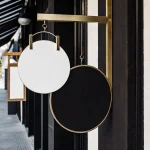
The Art and Science of Designing Storefront Signs That Captivate
The Art and Science of Designing Storefront Signs That Captivate
In the bustling world of retail, your storefront sign is more than just a nameplate—it’s the first handshake with potential customers. A well-crafted sign can draw in foot traffic, enhance brand visibility, and, ultimately, make or break a business’s appeal. For designers and architects, creating high-impact storefront signage is both an art and a science, requiring a blend of creativity and technical know-how.
Crafting the Perfect First Impression
Storefront signs are powerful tools for attracting customers and enhancing brand visibility. Designers and architects play a pivotal role in crafting these impactful signs, ensuring they align with the brand’s identity while standing out in a crowded marketplace. It’s about making that first impression count.
Typography and Color: The Dynamic Duo
The choice of typography and color can significantly influence a sign’s effectiveness. Bold fonts paired with contrasting colors ensure readability and attraction, even from a distance. Imagine a classic black and white combination or a vibrant yellow on blue—these choices can make a sign pop. Effective typography and color combinations are essential for capturing attention and conveying the brand message clearly.
Lighting Up the Night
Incorporating LED lighting into storefront signs is a game-changer for night visibility. LED lights not only enhance the sign’s visibility after dark but also add a modern touch. Different lighting techniques, such as backlighting or halo lighting, can create dramatic effects, making the signage stand out even more. It’s about making your brand shine, day or night.
Adding Depth with 3D and Reflective Elements
Adding 3D lettering to signage introduces depth and sophistication. This technique can make a sign more engaging and visually appealing. Reflective materials, on the other hand, catch the light and add an extra layer of interest, ensuring the sign remains noticeable at all times. It’s about creating a visual experience that captivates.
Transforming Windows with Graphics and Decals
Vinyl decals are a versatile tool for promotions and branding. They can be used to display seasonal offers, new arrivals, or simply to enhance the storefront’s aesthetic. Creative use of window graphics can transform a plain glass surface into a dynamic advertising space. It’s about turning every inch of your storefront into a canvas for creativity.
Shapes That Speak Volumes
Designing signs in unique shapes that reflect the brand’s identity can make a significant impact. Custom shapes not only attract attention but also reinforce brand recognition. For example, a coffee shop might use a sign shaped like a coffee cup to instantly convey its offerings. It’s about making your brand’s voice heard through design.
Keeping It Fresh with Seasonal Adjustments
Updating signage to reflect local events or seasons keeps the storefront fresh and relevant. Thematic adjustments, such as holiday decorations or event-specific graphics, can attract new customers and engage the community. It’s about staying in tune with the rhythm of the seasons and the pulse of the community.
Interactive A-Frame and Chalkboard Signs
A-frame and chalkboard signs are versatile options for promoting daily specials or events. These signs can be easily updated and moved, making them ideal for businesses that frequently change their offerings. Creative chalkboard designs can add a personal touch and invite customer interaction. It’s about creating a dialogue with your audience.
Monumental Impact with Monument and Marquee Signs
Monument and marquee signs are excellent for enhancing property value and delivering lasting messages. These large, permanent signs are often used by businesses to establish a strong presence in the community. Choosing the right materials, such as stone or metal, can ensure durability and appeal. It’s about making a statement that lasts.
Ensuring Accessibility with High Contrast
High-contrast palettes are essential for ensuring accessibility. Signs that are easy to read for everyone, including those with visual impairments, demonstrate a commitment to inclusivity. Designers should prioritize contrast and legibility in their designs. It’s about making sure everyone feels welcome.
Personalized Experiences with Dynamic Branding
Using data to create personalized messages and dynamic branding can significantly enhance customer engagement. Personalized signage that speaks directly to the audience can create a memorable experience and foster brand loyalty. It’s about making each customer feel special.
Exploring Creative Materials and Techniques
Exploring creative materials and techniques, such as hand-painted or vintage designs, can give a storefront sign a unique look. Material selection is crucial for ensuring both durability and aesthetic appeal. Designers should consider the environment and brand identity when choosing materials. It’s about crafting a sign that tells a story.
Inspiring Creativity in Every Design
Designing high-impact storefront signs requires a blend of creativity, technical skill, and an understanding of brand identity. By experimenting with different techniques and materials, designers and architects can create signs that not only attract customers but also enhance the overall brand experience. It’s about pushing the boundaries of what’s possible in signage design.
Join the Conversation
We’d love to hear your creative storefront sign ideas! Share your thoughts in the comments below. For more design tips and inspiration, subscribe to our blog and stay updated with the latest trends in signage design. Let’s keep the conversation going and inspire each other to create signs that captivate and engage.
For more information on custom storefront sign solutions, check out our Storefront Sign Design page.





Add a comment